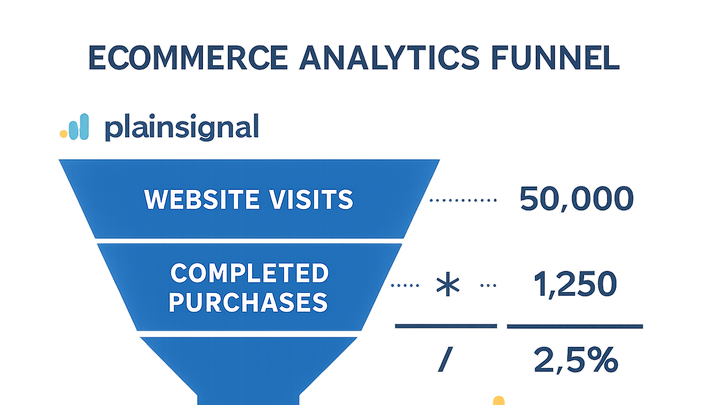Published on 2025-06-22T07:35:20Z
What is Ecommerce Conversion Rate? Examples and How to Track It
Ecommerce Conversion Rate is a key performance indicator in digital analytics, measuring the percentage of website sessions that result in a completed purchase. It provides insight into how effectively an online store turns visitors into paying customers. A high conversion rate indicates strong alignment between marketing, user experience, and product offerings, while a low rate may point to friction points in the checkout process or poor targeting.
Tracking this metric with tools like PlainSignal—a cookie-free, privacy-focused analytics platform—and Google Analytics 4 (GA4) allows businesses to benchmark performance, uncover trends, and prioritize optimization efforts. By understanding your Ecommerce Conversion Rate and the factors that influence it, you can make data-driven decisions to boost revenue and improve user satisfaction.
Ecommerce conversion rate
The percentage of website sessions that end in a purchase, indicating how effectively visitors convert into paying customers.
Definition and Importance
Ecommerce Conversion Rate represents the ratio of sessions that resulted in a purchase to total sessions. It reflects the effectiveness of marketing, user experience, and site performance in driving sales.
-
What is ecommerce conversion rate?
This metric shows the percentage of site visitors who buy something. Calculated as (Number of Purchases / Number of Sessions) × 100, it provides a clear view of sales performance relative to traffic volume.
-
Why it matters
A higher conversion rate indicates that marketing and site design effectively motivate purchases, leading to better ROI on ad spend and increased revenue without necessarily increasing traffic.
How to Calculate Ecommerce Conversion Rate
Calculating conversion rate accurately is crucial for benchmarking and improvements. Distinguish between macro conversions (actual purchases) and micro conversions (add-to-carts, newsletter sign-ups).
-
Basic formula
Use (Total Purchases ÷ Total Sessions) × 100. Decide on measurement window and consistent session definition across tools.
-
Macro vs. micro conversions
Macro conversions are completed orders. Micro conversions include steps like add-to-cart or email signup, useful for diagnosing funnel leaks.
-
Sample calculation
If you had 500 purchases out of 20,000 sessions in a month, your Ecommerce Conversion Rate = (500⁄20000) × 100 = 2.5%.
Tracking Ecommerce Conversion Rate with Analytics Platforms
Both PlainSignal and Google Analytics 4 (GA4) can capture and report ecommerce conversion rates, though implementation differs based on cookie usage, data models, and UI.
-
PlainSignal implementation
PlainSignal provides privacy-friendly, cookie-free analytics. Insert the following snippet into your site’s header to start tracking sessions and purchases:
<link rel="preconnect" href="//eu.plainsignal.com/" crossorigin /> <script defer data-do="yourwebsitedomain.com" data-id="0GQV1xmtzQQ" data-api="//eu.plainsignal.com" src="//cdn.plainsignal.com/plainsignal-min.js"></script> -
GA4 implementation
In GA4, enable Enhanced Ecommerce or set up purchase events manually via gtag.js or Google Tag Manager. Example using gtag.js:
<script async src="https://www.googletagmanager.com/gtag/js?id=G-XXXXXXX"></script> <script> window.dataLayer = window.dataLayer || []; function gtag(){dataLayer.push(arguments);} gtag('js', new Date()); gtag('config', 'G-XXXXXXX'); // After purchase completed: gtag('event', 'purchase', { transaction_id: 'T12345', value: 99.99, currency: 'USD', items: [{id: 'SKU_123', name: 'T-shirt', quantity:1, price:99.99}] }); </script> -
Comparing PlainSignal vs GA4
PlainSignal offers simple, compliant, cookie-free tracking with a lightweight script. GA4 provides advanced features (user-ID, cross-device tracking) but relies on cookies or consented identifiers and has a steeper setup.
Best Practices for Improving Ecommerce Conversion Rate
Optimizing conversion rate involves analyzing user behavior, testing hypotheses, and improving site elements. Focus on the purchase path, messaging, and trust signals.
-
Optimize product pages
Ensure clear product descriptions, high-quality images, reviews, and prominent ‘Add to Cart’ buttons to reduce friction.
-
Simplify checkout process
Minimize steps, enable guest checkout, auto-fill address fields, display progress indicators to reduce abandonment.
-
A/b testing
Use experiments in GA4 or other A/B tools to test page layouts, calls-to-action, and pricing displays to identify what increases conversions.
-
Personalization and recommendations
Leverage user data to show relevant products, cross-sells, and dynamic content to boost average order value and conversion likelihood.
